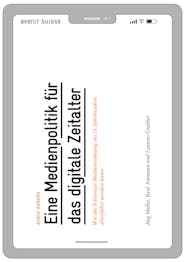Newspapers, radio, and television are increasingly losing their audience – this much is well known. But at the same time, a lot of new things have emerged in the media sector. Online platforms are recording steady growth in the number of people accessing them, traditional publishers have transformed themselves into multimedia organizations, and we’ve seen the establishment of new media startups. On an aggregate level, there are significantly more media professionals today than there were twenty years ago.
Steady Growth in Funding for the Media
Meanwhile, little has changed in terms of media policy – apart, that is, from an increase in the volume of media subsidies. Since the turn of the millennium, subsidies for the media sector have risen by over 20% to CHF 1.5 billion. These funds predominantly finance instruments of media policy that are out of date and not particularly targeted.
Today’s media subsidies thus lead to undesirable side effects. One example is distortions in competition: private media are crowded out, and media diversity suffers as a result. In the short term, such problems can be mitigated. In the long term, however, a new media order is needed in which market failure is specifically addressed.
Short Term: Reduce Problematic Side Effects
In principle, the overall framework for the media in Switzerland is good. What is problematic, however, is certain business engaged in by (partially) state-owned companies such as Swiss Post, as well as interventions at the municipal and cantonal level. This sometimes brings journalism dangerously close to politics and distorts competition.
The elephant in the room as far as the current media order is concerned is the SRG (the Swiss Broadcasting Corporation). It receives a good CHF 1.2 billion annually, which corresponds to more than 80% of Switzerland’s total media funding. It is thus the central component of the public media service. However, the current price/offering recipe laid down in its basic service remit no longer matches the digital world, and should be redefined accordingly:
- Offering: The SRG’s service remit should focus on media content relevant for the functioning of a democratic society that private companies do not offer. Alongside honing the offering, a binding revenue path should also be introduced for the SRG.
- Pricing: The old fee model was replaced in 2019 by a levy model that is tantamount to a special-purpose tax. A new “fee model 2.0” would be an option to reduce the compulsory fees and mitigate the distortions of competition around the SRG.
Long Term: Specifically Address Market Failure
Short-term measures will not be sufficient eliminate all the deficits of the outdated overall system. The authors of the study therefore also propose fundamental reforms:
- Strengthening the control function over projects and individuals:
Any failure of the market in terms of the generation of new knowledge (including in investigative journalism) could be addressed via project or personal funding along the lines of the way basic scientific research is funded. Various ideas are developed and discussed in the study. - Supplementing the media offering via a public content provider with license auctions:
In the long term the SRG should evolve toward becoming a public content provider which under a service remit generates relevant media content not produced by the market. Unlike the situation today, however, this media content would not be broadcast by the SRG itself, but would be auctioned off to private media organizations operating at the program level. What sounds abstract in theory is illustrated in the study using the example of a scenario.
Such a reform of media regulation would have various advantages. Media funding could be both more targeted and more efficient. Technological neutrality would be assured and competition would be distorted less than it is now, meaning less threat to media diversity. For Jürg Müller, co-author of the study, the matter is clear-cut: “Swiss media policy is out of date. We need new approaches to assure a supply of media content that is relevant to democratic politics.”






